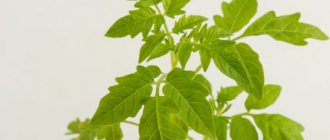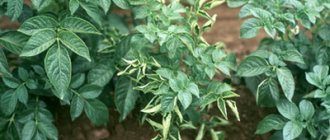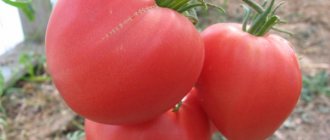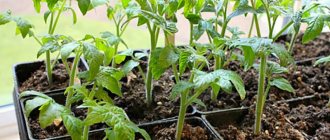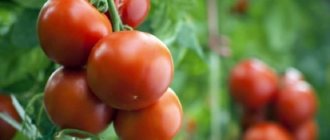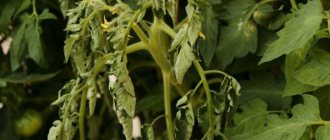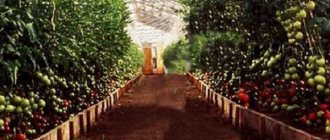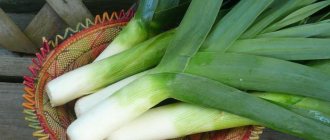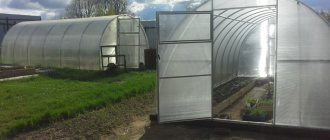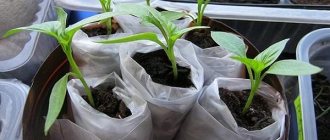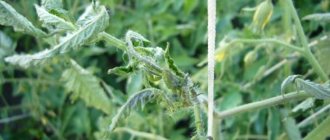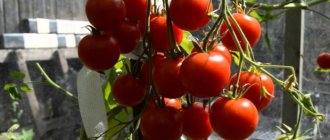In pursuit of the best, growing tomatoes using the method of I.M. Maslov became popular. The method itself does not contain anything new and unknown; as a rule, all vegetable growers know and have heard something about it, and many even use it in their own countries. However, I.M. Maslov systematized and justified every agrotechnical operation. Those vegetable growers who have already tried growing tomatoes using this method from “A” to “Z” respond very positively. Some took one thing from the technique and were just as happy with the result.
Basis of the method
By carefully observing a tomato plant, you can see that roots can grow from any point on the stem. Stepchildren also take root well, both bent to the ground and separated from the mother bush and placed in water. Watching the stepson in the water, you can see how root thickenings (white “pimples”) first grow throughout the shoot and then they turn into young roots. After some time, there is not even a small space left on the stem without a root shoot. It was this botanical feature that formed the basis of the method.
Option two: what does giving up stepson give?
Refusal to remove stepchildren allows you to:
- grow the bottom pair of additional stems;
- after the main stem produces its first fruits, the stepsons are bent to the ground, the leaves are removed, fixed with staples, covered with soil and moistened well.
In order not to greatly shade the main stem, the shoots are removed from the bush to the maximum distance. Stepchildren grow and develop very actively; fruits can be expected to appear on them a couple of weeks after the main stem begins to bear fruit.
This option has proven itself very well; it is called growing in three stems.
The root system of the plant remains common, the stems do not oppress each other.
To speed up the development of the root system while loosening the soil, it is recommended to hill up the bush a little, similar to how we carry out this procedure with potatoes.
The methods do not contradict each other, they can be used on the same bushes: first, horizontal planting is done, then the stepsons take root.
The effectiveness of the second method is especially noticeable in greenhouse conditions; it allows for the formation and ripening of fruits over the entire height of the plant.
When gartering tomatoes in greenhouses, you should be especially careful; the best option is to use loops made of nylon strips fixed to the roof and going down. For each shoot the loop must be separate.
Features of the seedling period
Talking about his method, Maslov recommended using overgrown seedlings. Experimenting with tomato crops, he repeatedly proved that a tall stem, when rooted, will naturally produce more roots, only because the area, linear meter, allows it.
To follow the biology of the plant and grow tall, overgrown seedlings, they need to be sown much earlier.
Many vegetable growers have already managed to improve Maslov’s method, and carry out repeated transshipment with transplanting into pots of greater and greater height, thereby achieving an increase in the root system long before the seedlings fall into open ground.
General information about tomato garter
Today, tomatoes grow on almost every plot. Often plants cannot cope with the load and break under the weight of the fruit. Tying up vegetables growing in open ground or greenhouses will help to avoid such a nuisance. Most often, a garter is necessary for tomatoes growing more than a meter in height. It is good to use supports that support plants. A little about the advantages of using a support:
- A tied plant accelerates its growth and development, making it easier to cultivate bushes;
- Garter is necessary for uniform ripening of the crop;
- The process of caring for Nightshades is greatly simplified;
- The support allows you to remove the load from the branches of the tomatoes.
Variety selection
When selecting seed, preference should be given to those tomatoes that plant the first cluster above the 9-11th leaf. Next, you need to choose varieties that do not have short internodes, so that the entire space can be abundantly overgrown with root shoots.
Consequently, low-growing, verminous, determinate varieties are completely unsuitable for this method.
By giving preference to a tomato variety or hybrid that is labeled as indeterminate, you can safely plant any. The choice of color, shape, use is yours.
When purchasing seeds, you should remember that the author of the method recommends sowing 5-7% more than the planting area allows. This is done so that the best, strongest specimens can be selected from all the seedlings.
We grow seedlings
Growing tomatoes according to Maslov has its own characteristics of the seedling period.
- Sowing must be done in advance. By sowing the seeds at the end of February, this will give us the opportunity to have more mature seedlings by the time they are planted in open ground;
- If ordinary seedlings are grown to be “plump”, low and dense, then these should be elongated;
- In order for seedlings to grow, it is necessary to withstand lighting and temperature conditions. The darker and cooler, the taller and “thinner” the seedlings;
- It is better to sow in groups and quite densely, then already at the first stage the seedlings will stretch upward;
- During the period of formation of the first true leaves, we carry out picking No. 1 and plant it in a box with a feeding area of 2 x 2 cm;
- After 2.5-3 weeks, actually after the first rooting, we carry out picking No. 2. To do this, we tear off the bottom two leaves and plant them in a common box with a feeding area of 3 x 3 cm;
- After the next 2.5-3 weeks, we again tear off two leaves and plant them again even deeper. This will be pick No. 3 and the feeding area will already be 4 x 4 cm.
Some vegetable growers grow without picking, but they do it in a unique way. For growing, take a 0.5 liter plastic container, transparent. A seed is sown at the very bottom and as it grows, nutrient soil is constantly added. Thus, the root system, by the end of the seedling period, occupies almost 25 cm.
Seed preparation
Tomato seeds
The key to good seedlings and high yields is high-quality seeds. Serious manufacturers treat them with special antifungal substances before selling them, which increases the germination of tomatoes.
You can disinfect seeds yourself using a solution of potassium permanganate (1 gram of substance per 1 liter of water). To do this, the seeds are wrapped in a piece of gauze and placed in the prepared liquid for twenty minutes. After the time has passed, the seed should be washed well in cool water and dried.
It is believed that tomato seeds remain viable for nine years. But improper storage conditions and various other factors can significantly shorten this period. If you doubt the quality of the seeds, you can check them in a simple way.
Two to three weeks before sowing, place a couple of seeds in a linen cloth in warm water for a day. Then leave in the same piece of paper in a warm place for 3-4 days. Afterwards, plant the seeds on the ground and watch the seedlings: sprouts have appeared - everything is fine with tomato seeds, there is no greenery - the seeds are not suitable for growing.
You can also select unsuitable seed material visually. Do not leave hollow, too small or large seeds.
To speed up germination, it is recommended to place tomato seeds on a damp cloth and cover with a wet napkin for 18 hours. All this time it is necessary to maintain sufficient humidity.
What should you feed tomatoes after planting in the greenhouse, in the ground, so that they are plump and tasty (Photo & Video)+Reviews
Planting in open ground
If you grow seedlings far enough from the planting site, you will need to be prepared for the difficulties of transportation. Seedlings grown in this way are quite voluminous; they are tall, elongated and fragile. Experienced vegetable growers manage to transport it not in a vertical position, but in a horizontal position, since it will be planted. Plants are stacked in a box on top of each other “jack” and are easily transported.
Maslov's method of growing tomatoes involves planting seedlings lying down - horizontally. To do this, make a fairly deep trench and fill it with water. Next, they allow the water to absorb and fill it with water again.
Almost 23 shoots of the seedlings are cut off and placed in ditches. Maslov recommends laying with the head facing north, so that the rooting site warms up well, and the seedling “forelock” will in any case rise and grow vertically.
However, according to agricultural experts, this can only be planted in the northern regions, where the sun is not very hot. In the southern regions, agricultural technology for planting seedlings involves planting elongated seedlings with their “heads” to the south, so that when they stand up, they cover the rooting site. If the area where the root is located and the stem is covered with soil is in the shade for at least some time, this will not allow it to overheat too much, and root formation will proceed better.
Having placed the plant in the furrow, cover it with 10-12 cm of soil mixture.
If planting is carried out in the northern region and the weather conditions for the tomato are not comfortable, then the rooting site should be covered with mulch material to prevent the young roots from getting too cold.
When planting, do not fill the trench at the same level with the ground; it should be well deepened.
Stage two. Soil preparation
You should start with the fact that you cannot grow tomatoes in the same place for several years in a row, otherwise you may encounter such a nuisance as fruit diseases. For this reason, tomatoes should be alternated with cucumbers annually. However, even in this case, microbes will remain in the soil. To protect crops from infection, you need to partially/completely change the soil in the greenhouse or, alternatively, remove 10-15 cm of the top layer.
Preparing soil in a greenhouse
Then the soil is treated with copper sulfate dissolved in boiling water (2 tablespoons per bucket of water). 14 days before transplanting, the soil is cleared of weeds, loosened and fertilized, after which the beds are formed. If only poor soil is available, then you need to add humus and coal (7 kg and 250 g, respectively, per 1 m²). But if the soil is fertile, then 3 kg of humus per 1 m² is enough.
In the photo there is fertilizer for a greenhouse
The soil in the greenhouse where the tomatoes will be planted is fertilized depending on its type.
- The loam needs to be softened and lightened by mixing it with sawdust and humus (10 kg per 1 m²).
- Peat soil must be mixed with sand (5 kg/m²), as well as sawdust, humus and turf (10 kg/1 m²).
- The same amount of sand should be added to chernozem as should be added to peat soil.
We also note that tomatoes should not be grown in the same greenhouse with cucumbers, since the latter need higher temperatures and air humidity.
The proximity of cucumbers and tomatoes in a greenhouse is not the best solution
Cultivation care
A plant planted in this way needs very abundant watering and very abundant feeding. How could it be otherwise? If we plan to get a huge harvest, and for this we have grown a huge root system, therefore, we need to provide a large amount of nutrients.
There is no point in growing rhizomes in fresh soil, no matter how many roots there are, there is nothing to take. No matter how those who recommend the method convince you that care is no different from usual, this cannot be so. Feeding should be carried out:
- regularly;
- in a timely manner;
- comprehensively;
- root and non-root.
To stepchild or not
Maslov convinces everyone that removing side shoots means reducing the yield. His method does not allow the removal of side shoots at all.
With stepchildren they act as follows: as soon as the stepson grows 25-30 cm, they begin to bend him down. It is better to do this when the plant has not been watered for several days and the turgor is slightly lost. Otherwise, if excessive force is applied, the stepson may break off.
The stepsons, which, under the influence of the tilt, have reached the ground level, are completely cleared of leaf plates and covered with earth, and then grown as a neighboring plant.
No matter how good the method is, regulate the number of stepsons yourself, otherwise you risk turning your garden into a jungle without achieving the desired harvest.
Disease and pest control
Tomatoes are very susceptible to various diseases. This culture is amazing:
tobacco mosaic;
Tobacco mosaic
- various types of fungus;
- late blight;
- crown rot;
- brown spot.
If you notice that individual plants on the site have already become infected with one or another disease, they will have to be removed. Otherwise, the disease can very quickly destroy the entire crop.
As for pests, the most dangerous for tomatoes are slugs, Colorado potato beetles, woodlice and caterpillars. Baits and insecticides can be used against them. Plants damaged by these pests should also be immediately removed from the site.
Nuances of care
When carefully considering the method, you should consider that the stepchildren will have to be rooted near the mother plant. This entire “structure” should be watered and intensively “fed”. You will need to somehow move between these plants in order to carry out agrotechnical measures.
Moreover, highly dense plantings in regions where late blight is often rampant will also introduce their own nuances, since there are no completely resistant varieties yet, and they will have to be processed frequently.
Looking at all the nuances, you should understand that for such planting it is necessary to allocate a meter by meter space for each bush. Initially it will seem that the plants are planted sparsely, but when the rooting of the stepsons begins, it will become clear that there is not even enough space.
Plants need staking in the same way as with other growing methods. However, if you are used to slender, neat rows, then with this method everything is more complicated. Maslov recommends tying it to a stretched mesh, otherwise the configuration in which you tension it will depend on your bush.
Step by step
- Prepare the wells. Their size should be sufficient to lay 2/3 of the length of the stem, and their depth should be at least 10 cm.
- Water the soil in the hole well.
- Place the tomato seedling and carefully cover it with soil. If you have not previously applied complex fertilizers, compost or manure to the site, it makes sense to apply pit fertilizer. To do this, fill the hole with the tomato with a mixture of compost, rotted manure and soil in a 1:1:1 ratio.
- Moisten the soil. Try not to let drops of water fall on the leaves and stems of the seedlings.
Attention!
Don't worry if the seedlings don't lift the top right away. Within a few days, the branches will reach towards the sun, and the seedling will take on a vertical position. Maslov himself practices arched irrigation on his farm, but this method is not suitable for everyone. It is quite possible to get by with standard watering at the root using a watering can or hose. In cases where access to water is not regular, and the weather in the region is hot with rare rains and dry winds, it is better to mulch the soil with a layer of bark, rotted straw, or sunflower husks; this will prevent active evaporation of moisture and retain it in the soil.
Planting a tomato
Maslov's method allows you to get large yields of tomatoes from one plant. Some gardeners claim that yields more than double. You, too, can use this method of growing tomatoes on your site and appreciate all its benefits. A rich harvest is guaranteed to you.
Advantages of the method
The greatest advantage of this method is that a small number of seedlings is needed. By planting several bushes and using stepchildren, we get a whole bush with a huge number of daughter plants.
When figuring out how to grow tomatoes using Maslov’s method, sometimes vegetable growers are perplexed about how to water it all. However, a technique was found here too. Grooves are dug around this entire planting and water flows through them. They also serve supplements. Some people find this very convenient, saving energy and time.
With the introduction of a drip system into vegetable growing, the issue of watering has become even easier. A “drop” laid in diameter and sectors will allow watering and fertilizing to be carried out regularly and in a timely manner.
When deciding to plant tomatoes using the Maslov method, do not plan a lot at once, plant several plants, and then, if you like it, expand the plantings. Having grown tomatoes once, adjust the method “to suit you” and perhaps you will forever abandon the traditional cultivation of tomatoes.
Technologies for growing tomatoes. Reflections on the experience of famous gardeners
There are as many tomato lovers as there are technologies for growing them.
Beginner vegetable growers, of course, adhere to the recommendations described in the literature, but then everyone makes some changes, adapting the technology to their weather, their soils, their needs, capabilities and desires. One needs a gigantic harvest to feed a large family, another is ready to be content with only summer salads, and considers winter preparations unnecessary, since canned fruits do not correspond to the gardener’s nutritional principles. There are as many tomato lovers as there are technologies for growing them.
However, while some simply grow tomatoes, others advertise their technologies, considering it necessary to introduce them into industrial vegetable growing.
It is difficult for a gardener to grow stocky, strong seedlings on a windowsill; it is difficult to create comfortable conditions for them. That’s why she reaches out to the light outside the window, turns pale, suffers either from excess water in the boxes, or from drying out soil and “atmospheric” drought in the room. As a result, gardeners end up with frail, rickety dystrophics.
It is difficult for a gardener to grow stocky, strong seedlings on a windowsill.
How then to plant such a long tree in a garden bed? For a long time, everyone realized that instead of a bed there should be a continuous ditch (or ditch), quite deep and long. It is very convenient to place a long plant stem in it - it will not break. And raise the top so that the top few leaves are above the level of the bed. And it’s easy to water when preparing for planting - throw in a hose, the water itself flows where it’s supposed to.
The scientific basis for the method is solid: tomato plants are capable and habitual of growing new roots from the stem. It seems to me that gardeners use this method in all ages and at all times. However, this is not yet a technology: a method available to every gardener will turn into it when the implementation of all stages leads to a predictable harvest.
Ads by
Methods of growing tomatoes by I. M. Maslova
Method one. The experimenter created excellent conditions for the seedlings, so he did not have dystrophic plants.
To make them so, he planted good seedlings vertically in the greenhouse and helped them stretch. And then he planted this sick one lying down in the furrows. Or seedlings are planted in the usual way. But the first stepsons are not removed, but are given the right to grow so long that they can be laid on the surface of the bed and covered with earth. Of course, all the leaves must be removed and the tops left above the soil. In about a month, the stepchildren will get used to their new role and grow roots and stems. Their fruits are formed closer to the mother stem, so they can lie on the ground. All these techniques were needed for the plant to grow a large, voluminous root system. This method allows you to turn a groove into a groove, that is, you don’t have to lift tons of earth “uphill.”
The more powerful the root system of tomato seedlings, the better
Second way. It will not be able to take root in garden beds because it is labor-intensive: after all, it is necessary not only to dig fairly deep ditches, but also to place them in the north-south direction so that the plant can receive all the solar energy that it is capable of receiving. According to Maslov, this technology option is suitable for industrial cultivation of tomatoes in fields.
Both methods are based on the ability of plants to grow a root system. Who doesn’t want to, after performing simple manipulations, collect 70 kg of fruit from each bush?
And the gardeners began their experiments, based on the results of which they came to the following conclusions:
- It's not a matter of overgrown seedlings with frail stems - such plants take a long time to adapt after planting. It is necessary to sow early using this technology; the plants should be grown strong, powerful, with thick stems, because “a thick stem with shortened fruiting axils” is the main condition for success; it will give a powerful root system.
- The gardeners even deliberately, as Maslov advised, sowed early in order to grow such frail seedlings. And the same varieties were grown in the usual way at the correct sowing time - using a long-tested conservative method. Result: the skinny, lanky ones took a long time to come to their senses after planting in the ditches, responded more slowly to watering and fertilization, and ultimately produced a smaller harvest than their conservative brothers.
- Adventitious roots actually form, but they are frail; they do not grow along the entire length of the buried part of the shoot, but only in the place where the tip comes out of the ground, and where they had already grown when the seed was sown.
- It is not the height of the seedlings that is important, but its age. The bushes must be strong, stocky, healthy and must be adapted to open ground by hardening. Then, even with conventional vertical growing, the bushes produce excellent yields.
To obtain a decent harvest, it is not the height of the seedlings that is important, but its age
5. Quote: “Even in the vegetable growing textbooks of the 50s and 60s, it was shown with pictures how to plant overgrown seedlings. And precisely obliquely, almost lying down.” That is, this method has long been known, and without Maslov, gardeners knew that when tomato bushes are hilled, adventitious roots begin to grow. 6. Ganichkina has a different opinion: overgrown seedlings should be planted vertically in the ground. So that the depth level is no higher than when the plant was alive in a seedling box or cup. After adaptation, you can begin hilling, but not immediately hide the entire stem in the ground, but gradually. The reason is simple: the roots grow strongly - the green mass grows actively - flowering begins later - harvesting begins later. 7. During the difficult preparation of the trench beds in the spring, you will also have to work hard in the fall: after harvesting, you need to remove the roots, but they simply cannot be pulled out by hand, they have to be dug up. There is a lot of time wasted both in preparing the grooves and in cleaning up spent roots. 8. The method is not suitable for the Urals: while the plant is lying down growing its root system, summer ends in August. Tomatoes planted vertically have time to produce a harvest, while those grown in the Maslov style by the same time only begin to show green ones.
For the Urals, Maslov’s method is not suitable - tomatoes do not have time to ripen in open ground
9. However, this method has a continuation in greenhouses. When growing tall plants (indeterminate tomatoes), the first cluster is tied above the 9th leaf. So they bury the “extra” part of the stem into the grooves so that the brushes are lower, closer to the ground. 10. Many sowed in February and early March. The seedlings were growing. When planting lying down, it took a long time to grow new roots, this slowed down the entire plant for about 2 weeks. This is especially noticeable if the first flower cluster has already formed. There are no breadwinners for the fruits that have set, they grow themselves. That is why there is no first and earliest harvest. 11. I tried this method too. There was a lot of greenery growing: if it had been cabbage, there would have been enough food for a whole farm of rabbits. And they just tore everything off and threw it away. They tormented the plants and gave themselves extra work. On soil well fertilized with humus (there were cows on the farm, there was plenty of manure), I did not observe a huge, powerful, branched root system. There were two lobes: one was a real native root, the other was near the surface of the earth, but there was still no main root. The root system was fibrous and located superficially. Extra watering was required. 12. Using Maslov’s method, a Moscow gardener grew tall tomatoes in a greenhouse. Grooves were dug in the garden bed in the greenhouse, and seedlings were planted in them lying down to build up a powerful root system. However, the record amount of 30 kg from the bush did not come easy. Spring heating of the greenhouse and autumn heating with wood (night shift of the fireman) were required until November. The plants were also given additional nutrition: jars with nutrient mixtures were placed on each stem (tomatoes can grow roots in the air in order to reach water, which is at a very close distance), so that the upper clusters could also gain weight and ripen. And the stepsons were buried.
We draw conclusions Only with fanatical care of plants (constant attention, summer life in the country, growing in a greenhouse heated from early spring to late autumn) can you get a lot of fruits on one plant, or rather, by your actions, force it to give a rich harvest. And in open ground - a maximum of 10 kg for tall tomatoes - this is the limit for Maslov’s technology.
Only with fanatical care in the greenhouse is it possible to get a rich harvest of tomatoes
Method of growing tomatoes F. M. Tarasenko
Tomato lovers are familiar with the name F.M.
Tarasenko. Not being a specialist agrarian, he managed to create several varieties of tall tomatoes, calling them lianas. The variety 'Jubilee Tarasenko' is especially interesting. You can always find 'Anniversary Tarasenko' on sale, as well as other time-tested varieties of tomatoes, using our market, where many products from different online stores are presented. Compare prices and choose tomato seeds.
Tomato Lorraine Beauty Yellow (Lottringa Beauty Yelloy), 5 pcs. Collector's grade 87 rub.
seedspost.ru
Tomato Duchess of Taste F1, 0.05 g 91 rub.
seedspost.ru
Tomato Emerald City, 20 pcs. The very best 41 rubles
seedspost.ru
Tomato Japanese truffle Red, 20 pcs. Tested in Siberia 32 RUR
seedspost.ru
To grow this miracle, we had to create a new technology for growing indeterminate tomatoes.
What's the point? In planting seedlings. The plant itself is huge, and the root system matches it. For seedlings 60 days old, you need a hole, which many gardeners dig for planting currants: 50cm x 50cm x 40cm. There should be a distance of 1 meter from the center of one pit to the center of the other. Each pit expects 2 buckets of humus, 4 cups of ash, 50 g of complex fertilizer to be poured into it; all this should be mixed with the top fertile layer removed when creating the pit itself. Grow seedlings in cups to preserve the roots when transplanting. In each hole, plant 2 plants in opposite corners. Water with very warm water, take 3 g of potassium permanganate for each bucket.
In stepsoning. When growing 'Jubilee Tarasenko', the stepsons are removed when they grow to 3-4 cm. There is no information about other varieties and hybrids on a special technique for tearing off or plucking the stepsons. By mid-July, the height of the plants should be almost 3 m. You need to pinch the shoots.
In crop regulation. Over the entire growing period there will be only 4 or 5 clusters on each stem. That is, there will be 8-10 tassels on two plant stems. All fruits cannot ripen before frost. Therefore, we have to normalize the number of clusters - cut off the top ones so that there are only 6 clusters on the bush.
In forming a bush and tying it to supports. The best supports are trellises. Not only the stems are tied, but also the brushes.
According to Tarasenko’s method, you need to tie up not only the stems, but also the brushes
All other technological methods do not differ from those needed for any giant tomatoes. The whole complex of measures will allow you to get 17 kg of fruit from each plant. Quite a lot! What is the experience of gardeners? But it’s not there... You can find a huge number of discussions about Tarasenko varieties, the taste and beauty of the fruits, the love of fruits with a spout, about collectors from whom you can buy seeds. But not a word about the most important thing, about technology. Therefore, I will tell you about my own experience.
In those early years, when everyone was sick with Tarasenko varieties, I also got sick with them. However, things didn’t go further than digging a few holes. In the fall (it is at this time that it is recommended to prepare holes), my husband refused this work: we were still actively building sheds, there was no time to remove soil for an unknown purpose. And in the spring of desire there was enough pit for four. And then the calculations began on what kind of porridge I should feed my husband so that during a shift (8 hours of working time) he could bring to the surface a cubic meter of soil, the mass of which is unknown, but approximately the same as a cubic meter of water weighs, that is, a ton. And this is only for planting 8 plants.
So we limited ourselves to four, and the rest were planted using our usual technology. Because in those years, we sold buckwheat only with coupons (for diabetics), but it was precisely this that allowed us to remove a cubic meter of soil per shift. Other porridges do not reach this intensity of labor. It seems that these pits have become stumbling blocks for many. Let the yield be lower! But there will also be less work.
Tarasenko grew his tomatoes in a warmer place than central Russia (in Shostka), so gardeners in Altai and the Novgorod region need to reconsider the timing of pinching and quantity. And depending on the specific weather in the year of cultivation, leave not 6 bunches of fruit, but perhaps less.
We preferred the less labor-intensive method to Tarasenko’s method.
The root system begins in a capsule
Gardeners have long been using milk and kefir packaging to grow seedlings: they have quite suitable sizes, and the height can be made as required.
That's where the 70 x 70 x 70 mm size came from. Such a “fermented milk” box is filled with soil mixture and a seed is sown in each corner. When real leaves begin to appear, you can see which plant is the strongest. So they leave him. At this age, the stem is thin and flexible. A trickle of water bends him to the ground. But the gardener himself needs to do this by drawing a fairly deep groove from the plant to the opposite corner of the box. And place the stem in this groove, sprinkle it down to the cotyledon leaves. And the top, as befits a plant, should stand straight and look up. And then F.I. Rigin waters the seedlings with a weak solution of potassium permanganate. Do this several times, no other feeding is required. After about 2 weeks, the plant develops a powerful root system.
Before planting in the ground, Rigin pre-plants the seedlings in larger bags. These can also be milk bags, but with a capacity of one liter. These are the same boxes, but cut differently - they have not the top removed, but one of the sides - it’s convenient to place seedlings in such containers! And fill all the free space with soil mixture. This is done for a new stage of root growth. In 2 weeks it will not be just a smudge of roots, it will be a powerful, dense broom. It is clear that a small hole for such a root system will be small. Because they dig it, it is also quite large, approximately 40cm x 40cm x 30cm. Fill with a nutrient mixture and plant the plants lying down, but do not cover them completely with soil. After a few days, the exposed top of the stem will rise on its own as it begins to grow. After a week, you need to fill the beds with plants with peat, straw, old sawdust, and feed the bushes with mullein.
Each gardener chooses his own preferred method of growing tomatoes.
Are there any secrets in these methods?
It’s unlikely: what’s good in Crimea may leave Tomsk without a harvest. But every technology, every method is an opportunity to find something truly unique for your garden. Some will be happy to dig wide and deep holes, while others will plant seedlings 15 cm high in the ground, for which they will make a hole with the fang of a flat cutter and the volume of a yogurt cup.
